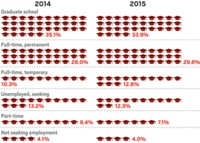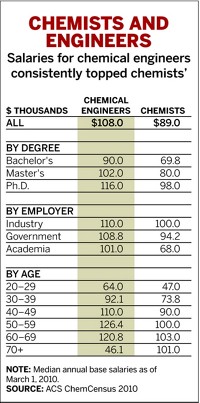Advertisement
Grab your lab coat. Let's get started
Welcome!
Welcome!
Create an account below to get 6 C&EN articles per month, receive newsletters and more - all free.
It seems this is your first time logging in online. Please enter the following information to continue.
As an ACS member you automatically get access to this site. All we need is few more details to create your reading experience.
Not you? Sign in with a different account.
Not you? Sign in with a different account.
ERROR 1
ERROR 1
ERROR 2
ERROR 2
ERROR 2
ERROR 2
ERROR 2
Password and Confirm password must match.
If you have an ACS member number, please enter it here so we can link this account to your membership. (optional)
ERROR 2
ACS values your privacy. By submitting your information, you are gaining access to C&EN and subscribing to our weekly newsletter. We use the information you provide to make your reading experience better, and we will never sell your data to third party members.
Careers
Demographics Of Chemistry
New data shed light on racial/ethnic makeup of chemistry graduates
by Michael Heylin
September 17, 2007
| A version of this story appeared in
Volume 85, Issue 38
FOR ITS PAST THREE annual reports, the American Chemical Society Committee on Professional Training (CPT) has revised and standardized the way it solicits information on the race, ethnicity, and citizenship of new chemistry graduates. The changes are to ensure completeness.
The data confirm the high percentage of graduates who are not U.S. citizens—a little more than 30% of master's graduates and about 40% of Ph.D. graduates, as well as 4% of the bachelor's. They also confirm the continued modest representation of African Americans and Hispanic Americans and the elevated role of Asian Americans.
This new input adds to the insight into the demographics of the chemistry community that is available from ACS's long-established annual surveys of new chemistry graduates and of the salaries and employment status of ACS members in the domestic workforce.
The new CPT data for the 2003-04, 2004-05, and 2005-06 graduating classes do not provide definitive evidence of any unexpected trends. Three years is too short a period for that. But they hint that the percentage of Ph.D.s earned by noncitizens is on the rise.
According to CPT, African Americans earned about 7% of the bachelor's degrees awarded from 2004 to 2006, 4% of the master's, and 2% of the Ph.D.s. Hispanic Americans did about the same with 5, 6, and 3%, respectively. Asian Americans earned about 14% of the bachelor's degrees, 7% of the master's, and 6% of the Ph.D.s. Non-Hispanic whites held at about 69% of the bachelor's, 51% of the master's, and 49% of the Ph.D.s.
All of these data from CPT need to be handled and interpreted with a little caution. This is because of the way they are gathered. What CPT conducts every year is a census, not a survey. It is mandated that schools with chemistry programs approved by ACS report to CPT every year on all their bachelor's, master's, and Ph.D. graduates.
The questionnaire that departments complete and return to CPT requires the departments to assign each individual graduate into one, and only one, of seven categories—African American, Asian American, Native American, Hispanic American, white (non-Hispanic), international (non-U.S. citizen), and unknown. The number of assignments must add up to the number of graduates.
No system for gathering data on the racial makeup, ethnicity, and citizenship status of a group is perfect and satisfies everybody. The system used by CPT is no exception. For instance, it provides no racial information on graduates who are identified as non-U.S. citizens.
The data provided to CPT are also a little soft. Into which single category should a white (non-Hispanic) graduate who is not a U.S. citizen be placed? What about an African American who is Hispanic? Resolving such questions is left up to those filling out each department's return.
The CPT data indicate some demographic variations by department size. Dividing departments into three groups of about 200 each by the size of the faculty-up to eight, nine to 15, and more than 15-reveals that the percent of bachelor's graduates who are white non-Hispanics falls from 81% for the smallest departments to 74% for the middle range and to 63% for the largest. Asian Americans are particularly strong at the largest departments, 19%.
CPT's data do not allow for an analysis of race, ethnicity, and citizenship by gender. But they do provide the percentage of all graduates at the three levels who are women and confirm their continuing progress. The percentage of all bachelor's graduates who were women rose from 50.8% for the class of 2004 to 51.9% in 2006. The two-year gain at the master's level was from 46.8 to 48.6% and for Ph.D.s, from 32.9 to 35.8%.
The data for ACS's annual survey of new chemistry graduates come from the individual graduates who return the survey's questionnaire. It asks about race, ethnicity (Hispanic/non-Hispanic), and citizenship in separate questions. This means, among other things, that the information on race is complete for all respondents.
On this basis, in 2005, 79% of all bachelor's respondents were white, as were 76% of master's graduates and 66% of Ph.D.s. Asians, again, were strong with 9% of the bachelor's degrees, 23% of the master's, and 28% of the Ph.D.s. Response to the question on ethnicity revealed 6% of bachelor's graduate to be Hispanic, as well as 7% of master's and 3% of Ph.D.s.
ACS's annual salary and employment survey of ACS members in the domestic workforce also uses a questionnaire to gather information directly from individual chemists. These data bring out the demographic changes that the chemistry community will see in the coming years.
In 2005, 82% of working Ph.D. chemists were white. This compares with the 66% of Ph.D. graduates that year. The 15% of working Ph.D.s who were Asian compares with the 28% of graduates.
The consensus prognosis for the community of working chemists in this country from the new CPT data and from ACS's two surveys is for a decreasing percentage of whites, more Asians, slightly more Hispanics and maybe African Americans, more women, and more noncitizens.






Join the conversation
Contact the reporter
Submit a Letter to the Editor for publication
Engage with us on Twitter